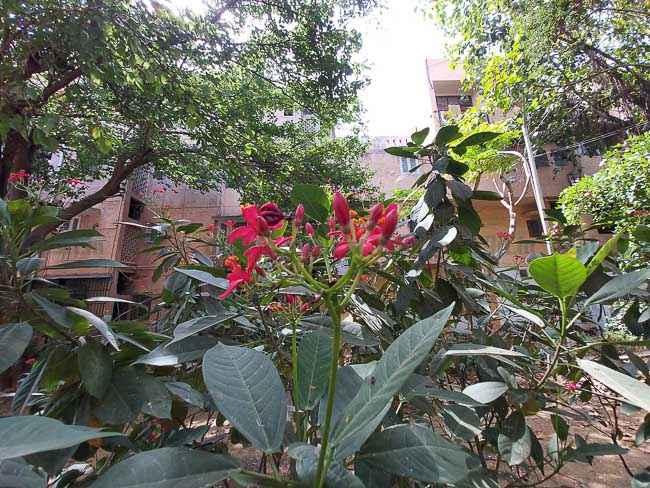Samsung Galaxy A70 128GB Review
Pros
Premium designSamsung Pay is a convenient feature to haveGreat battery life complimented with 25W fast charging
Cons
Average cameraFrustratingly slow fingerprint sensor
The Samsung Galaxy A70 is average for a mid-range performer but adds value to the package due to its design, Samsung Pay, a thoroughly polished OneUI and reliable battery life. Where it falters dearly is in the camera department and that infuriatingly slow fingerprint scanner.

Build and Design
One of the most striking features of the Samsung Galaxy A70 is its design. It comes in three colours; Blue, Black and White. Our review unit is the black variant and it isn’t a boring looking finish by any means. Besides having a micro-texture underneath the glass black, there is also a prism finish which shows up as a rainbow coloured glare as you twist the phone side-to-side. It’s a nice touch that lends a rather premium look the phone. The polished metal frame that holds the front and back glasses together is elegant as well. The only downside to this setup is the fact that the back and the frame hold fingerprints rather easily. The phone is better off in a TPU case, which doesn’t take away from the looks, but we do fear that over prolonged use, the case could start turning yellow.

For the buttons, the Samsung Galaxy A70 distinctly lacks a dedicated
Bixby button and we’re frankly happy about that. Both the power button
and volume rocker can be found on the right-hand side of the phone. The
power button is still easy to reach, but the 6.7-inch display makes the
volume up key a little hard to reach for those who have small to average
sized hands. The SIM tray sits beautifully flush with the metal frame
on the left side, with the only sign of its presence being the hole for
putting the SIM ejector tool through. The bottom side of the phone
houses the 3.5mm headphone jack, the Type-C charging port and the
singular speaker.

Overall, the design of the Samsung Galaxy A70 is definitely more premium for the weight-class its throwing punches in. Would have been nice if the phone had an IP rating, which would have definitely made it a lot more lucrative, but for now, it’s a feature we can live without.
Display
The Samsung Galaxy A70 comes with an FHD+ Super AMOLED display, with a resolution of 2400×1080. Given the 6.7-inch display and the water-drop notch that houses the front-facing camera, the pixel density is sitting at roughly 393 ppi. In terms of usability, the Super AMOLED display shines in the mid-range segment, besting most with its vividness and colour reproduction. Capable of peak brightness of 578 lux and a minimum of 7 lux, the A70’s display offers a fairly good gamut of visibility.
Using the phone outdoors, we see the Super AMOLED panel retain its contrast and saturation at peak brightness. Where it falters is in its handling of reflections. We found the Samsung Galaxy A70’s display to be oddly reflective, something that we haven’t seen in a while on a Samsung panel. The display does not come with a screen protector pre-installed, which usually tends to be the spoilt-sport in such cases, but turns out, the A70’s panel is just reflective. Dark coloured content tends to be incredibly difficult to view due to ambient reflections. There really is no way around this problem except to either cup the display with your hand or to find a spot with some shade. Indoors, however, the reflections are not a problem. The display dims down to 7 lux, which again is slightly on the higher side for AMOLED displays, but it is still comfortable to use in pitch-dark conditions.
So, to sum up, the Super AMOLED display on the Samsung Galaxy A70 is beautiful for watching movies and what not and great for gaming given the real-estate. Where it falters is in outdoor viewability, where dark coloured content tends to become very difficult to see due to reflections. Barring that, the A70 has an incredibly vivid display that is hard not to like.
Performance
Samsung has chosen to release the Samsung Galaxy A70 with the Qualcomm Snapdragon 675 chipset paired with 6GB RAM. We are pretty happy with Samsung’s choice of going with a Snapdragon processor over the Exynos, given the former’s superior GPU performance. We benchmarked the Samsung Galaxy A70 in our usual suite of tests and here is how the phone stacked up.
Camera
The Samsung Galaxy A70 sports quiet a commendable camera stack. There’s the 32-megapixel primary camera with an aperture of f/1.7. This is the GD1 sensor which can spit out images in 32 megapixels or bin them into an 8-megapixel image with better quality.
The Samsung Galaxy A70 by default shoots at 8 megapixels and changing the resolution isn’t something you’d find in the camera settings like one would traditionally expect. Instead, it is an icon on top of the camera interface, which is very easy to mistake for “aspect ratio” settings rather than resolution.
Shooting in daylight, the Samsung
Galaxy A70 produces some very good-looking images, but stutters in
handling backlit subjects. In some cases, it managed to expose properly
for the backlit subject and in some, it grossly underexposed the
subject, despite repeated attempts to fix the situation. The autofocus
also worked fairly well, although we were surprised to find the rather
large minimum focusing distance on this camera, preventing any kind of
macro photos.

The
Galaxy A70 has a triple camera setup, the second of which is an
8-megapixel ultra-wide camera with an aperture of f/2.2. Frankly, we’re
not very happy with the ultra-wide performance on any Samsung camera. It
lacks autofocus and exhibits wild amounts of distortion, not conducive
for shooting people or straight lines in general.

When moving to low light, we see the Samsung Galaxy A70’s primary camera do relatively well, delivering noise-free, sharp images. It does tend to lose sharpness towards the edges, a feature that is once again far more pronounced in the ultra-wide camera. You can see a larger collection of images in the Flilckr Gallery below
Selfie Camera
The front facing camera on the Samsung Galaxy A70 uses the same 32-megapixel sensor as the primary rear camera but has a slightly smaller aperture of f/2.0. this results in slightly lesser quality of selfies in comparison to the rear camera, but it is still a rather impressive result. Day-time selfies are again clear and sharp, but in order to achieve the sharpness, you have to turn off the beautification. In low light, the camera does falter due to the low aperture. Had Samsung retained the f/1.7 aperture on the front facing camera as well, we’d have a very strong contender in this segment, but for now, it remains a just about average shooter.




